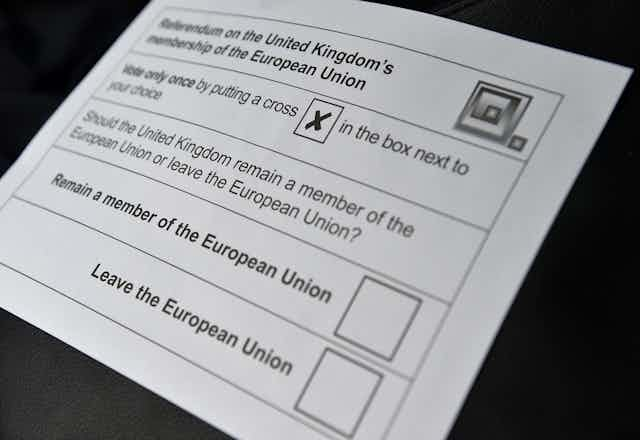Thursday’s referendum on whether the United Kingdom remains in or leaves the European Union may well take the country into uncharted political and constitutional territory. How will the Brexit referendum work? And what distinguishes it from referendums that have been held in Australia?
A constitutional rarity
Referendums are rare in the UK. While Australians have voted in nationwide referendums on 44 proposals to amend the Australian Constitution since 1901, Thursday’s vote will only be the third-ever UK-wide referendum.
Unlike Australia, there is no constitutional requirement in the UK to hold referendums on particular topics or in particular circumstances – and there is no codified constitution to amend. There has even been scepticism about whether referendums are compatible with Britain’s system of parliamentary democracy or are really “a device of dictators and demagogues”.
And so the EU referendum was triggered not by a constitutional requirement, but because David Cameron’s Conservative Party promised in 2015 to give voters “a say over whether we should stay”. The promise was put into effect in the European Union Referendum Act.
The independent Electoral Commission set the question as:
Should the United Kingdom remain a member of the European Union or leave the European Union?
And so the two competing sides are referred to as “Remain” and “Leave”.
At an Australian constitutional referendum, it is compulsory to vote. For the Brexit referendum, voting is voluntary. This means that both official campaigns have been devoting considerable effort to ensuring their supporters show up to vote.
At present, if bookmakers are to be believed, the expectation is turnout will be somewhere around 70% – at the 2015 election it was 66%.
But what would Leave look like?
When Australia holds a constitutional referendum, voters are able to know precisely what they are voting on. Under Section 128 of the Constitution, a detailed amendment bill needs to have gone through the parliament before a referendum can even be held.
In the 1999 referendum on an Australian republic, for example, the full proposal was available to be scrutinised and reviewed by voters beforehand – right down to exactly how the Australian president would be chosen.
This can have disadvantages, not least for those proposing the change: the proposal gives a hostage to fortune. But it has a tremendous advantage for voters, who can know what they will get if they vote “Yes”. And when an Australian referendum passes, the governor-general assents to the proposal to become part of the Constitution.
British voters are not in this position.
Remarkably, there is no official proposal on what the UK or the EU will look like after a vote to “Leave”. Voters are not being asked about a detailed, agreed, plan. Instead, a Leave vote will trigger the possibility of years of EU-UK divorce negotiations under the Treaty on European Union to figure out all the details.
On what conditions would the UK trade with EU member states after a Leave vote? What would be done with the EU citizens living in the UK and the UK citizens living in the EU? How would the UK go about negotiating new trade deals with non-EU countries? Which EU laws would be retained?
These questions are not unanswerable. But, for now, they are unanswered.
This means, as well as having an in-principle argument about whether or not Britain should leave the EU, Britain is having a parallel argument about what it would practically involve if it left the EU.
This has led to a confusing campaign characterised by uncertainty. Remain has argued that the unanswered questions can only be resolved in complex – potentially disastrous – ways. Leave has argued these questions will be answered with straightforward advantageous solutions. But no-one knows for sure, and the arguments take place side-by-side, to the disadvantage of British voters.
Divided we fall?
In Australia, it is notoriously difficult for a referendum proposal to be approved by the voters: only eight of 44 proposals have received a “Yes” vote.
In part, this difficulty is due to the “double majority” referendum requirement: a proposal must receive not only a majority of voters nationwide, but also a majority of voters in a majority of the six Australian states.
The UK is made up of England, Scotland, Wales and Northern Ireland. There is no special majority requirement for the Brexit referendum. This means a big “Leave” vote in England could be sufficient to ensure a “Leave” result – even if Scotland, Wales and Northern Ireland vote to “Remain”.
But while there is no special majority requirement, Scottish First Minister Nicola Sturgeon has made it clear that an overall “Leave” result may cause her pro-EU government to pursue a new referendum on Scottish independence from the UK. An English-led decision to take the UK out of Europe could thus lead to a renewed Scottish push to take Scotland out of the UK.
A decision to Leave could also have ramifications for Northern Ireland. Discussion is already underway about a post-Brexit need to reinstate border controls at the UK’s only land border, between Northern Ireland and the Republic of Ireland. Others worry Brexit could threaten the basis of the Northern Ireland peace process.
As a matter of raw politics, it seems plain that David Cameron would not last very long as prime minister in the event of a Leave vote. The referendum campaign’s nature and tone may have hastened his retirement as prime minister even if there is a Remain vote.
The Brexit referendum has created uncertainty in Britain and beyond. That uncertainty may well continue even once the results are known.

